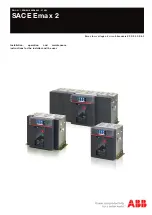
E-37
ENGLISH
When checking the characteristics of ETR with field test devices Y-2005 and Y-2000 (discontinued model), it is
necessary to set the characteristic setting switch of ETR as follows.
1. When testing the over-current tripping
operation or pre-alarm operation with the
signal output pin of the field test device
set to S1 or S3
When performing an over-current operation
test by setting the signal output pin of the
test device with ground fault protection
characteristics (GF) at S1 or S3, turn the
ground fault time (Tg) setting switch to
the “ALARM” side.
If the test is performed with the ground fault
time (Tg) setting switch set to the “TRIP”
side, tripping may be caused by the ground
fault operation depending on the setting of
the ground fault operation characteristics.
In such cases, the over-current operation
cannot be checked.
(Note)
For the operating procedures of field test devices Y-2005
and Y-2000 (discontinued model), refer to the instruction
manual included with the field test device.
17.4 Precautions when checking characteristics using the
fi
eld test device
CAUTION
Before performing the test, make sure that no
power is supplied to the main circuit of the circuit
breaker. There is a risk of an electrical shock.
2. When testing the ground fault tripping
operation or ground fault alarm output
with the signal output pin of the field test
device set to S2
If the ground fault tripping operation or
alarm output is tested with the signal out-
put pin of the test device set to S2, make
settings so that the short time delay pick-up
current (Isd), short time delay operating time
(Tsd), and instantaneous pick-up current (Ii)
setting values are higher than the ground fault
current (Ig) and ground fault time (Tg) values.
If the above settings are not made, the
ground fault operation cannot be checked
in some cases as a result of tripping by the
over-current operation.
(Example)
Rated current setting (Ir) : 0.5 × In
Ground fault current (Ig) : 1.0 × In
Ground fault time (Tg) : 0.3 s (TRIP)
1.15
(xlu)
1
.92
(OVER)
TEST
TRIP
ALARM
(s)
L/S LOCK
.84
.76
.68
1
.9
3
3
1.5
1.5
.15
.15
.1
.1
.8
.8
.5
.5
.3
.3
.7
.5
.3
.1
RESET
Tg
Tg
(xln)
Ig
Ig
Ip
TEST
Freq.
50Hz
60Hz
GF
GF
TYPE S1
RUN
ERR.
PAL
Ip
Iu
Isd
Tsd
I
T
LTD
STD
INST
i
I
2
t
L
OVER
100
Ir
(
×
In)
Iu
(
×
Ir)
Isd
(
×
Ir)
I
i(
×
Ir)
I
2
t
ON
I
2
t
OFF
T
L(s)
Tsd
(s)
INST
1
16
16
12
12
10
10
8
6
4
2
2
4
6
8
.9
.8
.7
.6
.5
MCR
Iu
×
2
80
60
%lu
1
.96
.92
.88
.84
.8
10
8
6
4
3
2.5
2
1.5
150
100
50
25
12
.5
.5
.3
8
8
.1
.06
.06
.1
.3
When Tg is 0.3 s,
set the STD time
(Tsd) to 0.4 s or more.
When ground
fault current (Ig) is 1.0.
When ground
fault time (Tg) is 0.3 s.
When rated current
setting (Ir) is set to 0.5.
When Ir is 0.5 and Ig
is 1.0, set the
instantaneous pick-up
current (Ii) to 4 or more.
When Ir is 0.5 and Ig is
1.0, set the short time
delay pick-up current
(Isd) to 2.5 or more.
Field test device (Y-2005)
or
TRIP
ALARM
(s)
1
.9
3
3
1.5
1.5
.15
.15
.1
.1
.8
.8
.5
.5
.3
.3
.7
.5
.3
.1
Tg
Tg
(xln)
Ig
Ig
Freq.
50Hz
60Hz
GF
GF
Set the Ground fault time
(Tg) to the ALARM side.










































